Abstract
The globalization and digital economy require adaptation of businesses to new conditions. Despite the fact that many scientists have studied the problems of doing business, the issues of risk management are understudied. The key to business efficiency, its competitiveness is the effective use of information resources, protection of the business information base. The momentum for implementing the new technologies and operating models needed to achieve these benefits is constantly growing. The risk function, which has significantly increased its spending over the past decade, should be no exception. Indeed, we are beginning to realize that the disappearing digital transformation creates real value for the company by improving the efficiency and quality of risky solutions. The digital risk function also provides more effective monitoring and control, as well as more effective compliance with rules. The implementation of various information systems can solve the issues of completeness, reliability and confidentiality of information. A key position of the market economy is the continuous search for assets that generate income that exceeds average profitability; in the digital economy, these positions are unchanged, but there are other horizons for businesses, competition strengthens, which makes businesses to adapt to the conditions of the digital economy. The authors studied existing business risks and defined the concept “business risk”. It is obvious that the scope of competition will expand if the risk is minimal. The crucial issues are as follows: how to do business with minimum risks. The authors developed a business model of the online platform for business communities.
Keywords: BusinessriskIT-technologiesdigitalization
Introduction
In the context of the digital transformation of the economy, the successful digitalization of businesses is crucial (Teece, 2018). The authors pay special attention to risk management issues in business communities.
Problem Statement
The process of business transformation requires the internal control over business processes and high-quality information protection. Digital technologies can be not only a catalyst for growth, but also a disruptive factor with far-reaching consequences for the economy. Productivity, employment, and well-being. While new technologies create business opportunities workers and citizens to engage in economic activities, these technologies are also likely to be the displacement of workers performing specific tasks, can lead to a further widening existing gaps in access and usage, which will lead to the emergence of new the digital divide and even greater inequality (Curran, 2018). This report assesses the main risks in business and their role in the transformation of the economy.
Research Questions
Of course, we are talking in particular about security threats in the context of rapid technological innovation and growing globalisation and interconnectedness (and hence the reliance on digital technologies that underpin this combined digital business). In the current conditions of the digital economy, there are various definitions of the concept “risk” (Robbins, 2018).
Purpose of the Study
For a business that is actively working in the "digital economy", it is highly important to own it in the guise and accept that there is a large number of fluctuations, and reselling the benefits for themselves will not always reduce it. Technological evolution is not only seen as a risk in the sense of security. Let's face it: almost all organizations are still afraid of the impact of technological innovations on their business models and the latest outcome (Elder-Vass, 2018). They understand that there is no other choice but to develop and increase their personal pace in order to close the gap between where they are present and the speed with which digital evolutions occur in the lives of customers and in the markets in which they work.
Research Methods
The research methods are as follows: 1) general research methods: analysis, generalization, analogy and abstraction; 2) empirical research methods: observation, description, comparison; 3) theoretical research methods: idealization and formalization, systematization of scientific knowledge – typologization and classification.
Findings
Kotlyarova defines the concept as a direct event caused by some factors which provoke a deviation from the planned goals of the project (as cited in Loren, 2018).
However, these definitions do not reflect the nature of business risks.
The authors define the concept "business risk under the digital transformation" as a probability of occurrence of adverse events for the company.
As part of the study, it is necessary to classify business risks. Having studied the existing classifications of business risks, the authors developed their own classification which can reduce business risks (Figure
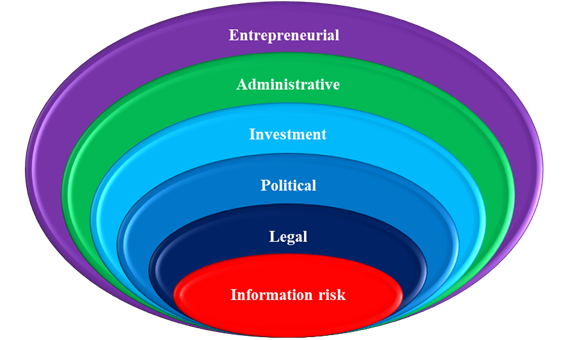
Special attention is paid to the information risk because companies need maximum protection from risks arising in the process of business transformation, as the basic information and business processes are being digitalized. Figure

The current level of development of economic relations requires the modernization of the national economy. Business development remains one of the key areas of development of the digital economy (Levitsky, 2017). Existing business models are being transformed, the added value model is changing, and economic effects of intermediation are being reduced (Veretekhina et al., 2017). However, the digitalization processes do not change the entire system of economic relations, transforming part of the processes, transferring them to the IT sphere, creating new directions for the development, while the sphere of material production remains unchanged. The primary goals of a business risk management program depend on its digital strategy. Therefore, we can assume that in the competitive environment, businesses also affect risks (Toffler, 2018).
Figure
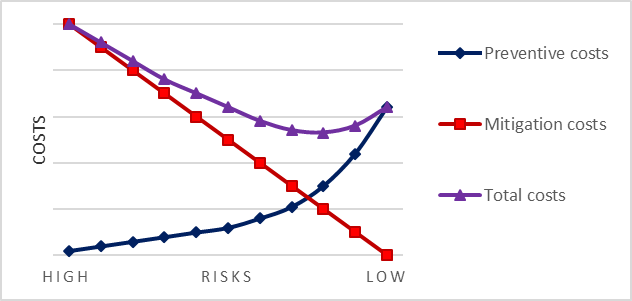
Figure
There are basic risk assessment methods (Figure
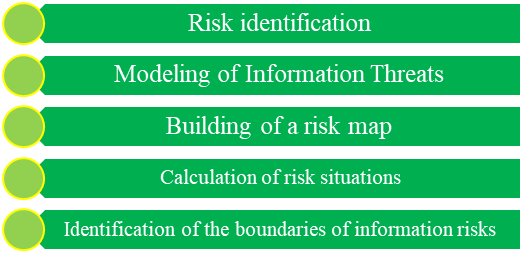
The Internet is an available means of communication. Hackers can use it. Protection of information is crucial for businesses. Business representatives should understand that information security can be threatened (Figure

The key findings of the Allianz Risk Barometer published annually by the Allianz Global Corporate & Specialty revealed what risks companies faced in 2019 (Figure
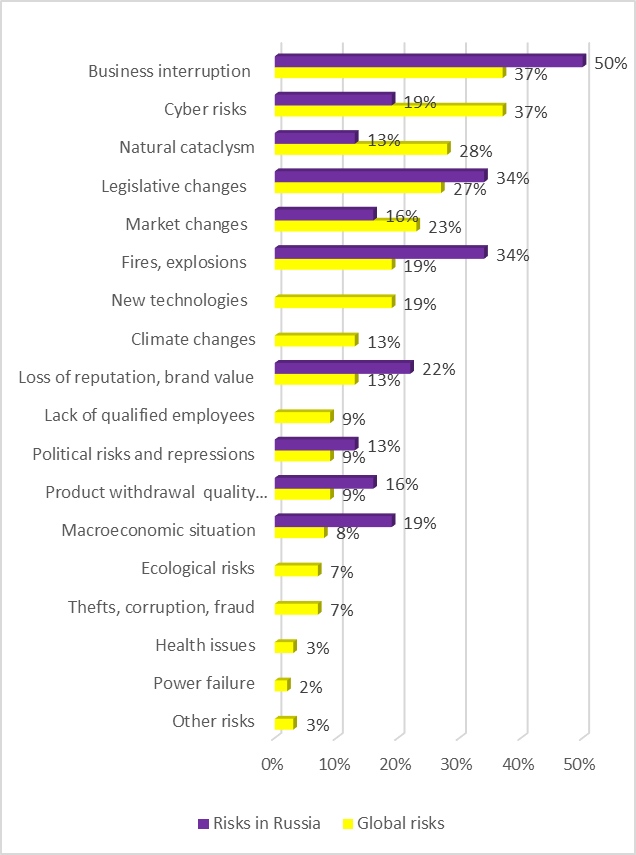
Figure
At the intersection of the physical and digital worlds, in the process of interaction between people and smart devices, “digital” business develops. This is the digital transformation.
A well-built model of “digital” business is a set of business-determining decisions made for profit extraction. The general availability of the Internet creates special conditions for doing business (Veretekhina et al., 2017).
The business model developed by the authors includes strategic concepts that represent actions aimed at achieving business goals (Figure
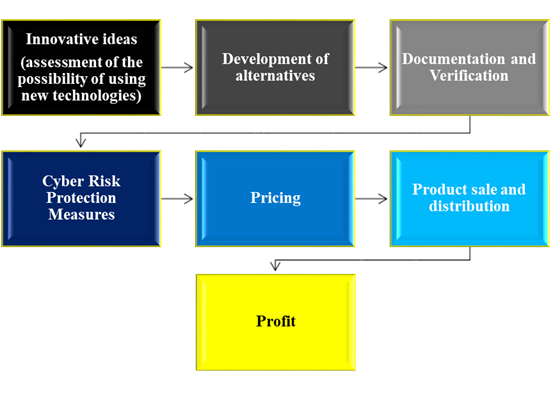
To conclude, it is necessary to take into account consequences of the Internet transformation and creation of new forms of values, expansion of the composition and number of participants in the global financial relations.
Conclusion
It is necessary to analyze risks in order to prevent or minimize them. The digital business platforms should be implemented as soon as possible.
This will primarily contribute to the competitiveness and maximum profitability of companies.
References
- Curran, D. (2018). Risk, innovation, and democracy in the digital economy. Europ. Journal of Socical Theory, 21, 207–226.
- Elder-Vass, D. (2018). Lifeworld and systems in the digital economy. European Journal of Social Theory, 21, 227–244.
- Levitsky, M. (2017). Speech at the Int. Conf. “Youth of the 21st century: Professionalism – the future of the country” (11 May). Retrieved from: http://vm.ru/news/378552.html
- Loren, L. (2018). The end of ownership: personal property in the digital economy. Issues in Science and Technology, 34, 91–93.
- Putin, V. V. (2017). 100 and 1 quotes. Compiled by S. M. Henkin, I. A. Istomin, S. M. Kretov -192. With Vladimir Putin. Comparative politics, 8(26), 161.
- Robbins, M. (2018). Internet, industry and International trade: Digital tradability in services. Journal of World Trade, 52, 229–255.
- Teece, D. J. (2018). Profiting from innovation in the digital economy: Enabling technologies, standards, and licensing models in the wireless world. Research Policy, 47, 1367–1387.
- Toffler, E. (2018). Metamorphosis of power: knowledge, wealth and power at the threshold of the XXI century. Moscow: Publ. House “AST”.
- Veretekhina, S. V., Shinkareva, O. V., Kozhaev, J. P., Telepchenkova, N. V., Kuznetsova, E. A., & Zaitseva, N. A. (2017). Evaluation methodology of the multiplier effect for the region as the result of the cluster formation. Eurasian Journal of Analytic Chemistry, 12(1), 1.
Copyright information

This work is licensed under a Creative Commons Attribution-NonCommercial-NoDerivatives 4.0 International License.
About this article
Publication Date
07 December 2020
Article Doi
eBook ISBN
978-1-80296-095-2
Publisher
European Publisher
Volume
96
Print ISBN (optional)
-
Edition Number
1st Edition
Pages
1-833
Subjects
Management, human resources, resource efficiency, investment, infrastructure, research and development
Cite this article as:
Timchuk, O. G., & Evloeva, M. V. (2020). Key Risks Of Digital Business Transformation. In A. S. Nechaev, V. I. Bunkovsky, G. M. Beregova, P. A. Lontsikh, & A. S. Bovkun (Eds.), Trends and Innovations in Economic Studies, Science on Baikal Session, vol 96. European Proceedings of Social and Behavioural Sciences (pp. 635-640). European Publisher. https://doi.org/10.15405/epsbs.2020.12.82

